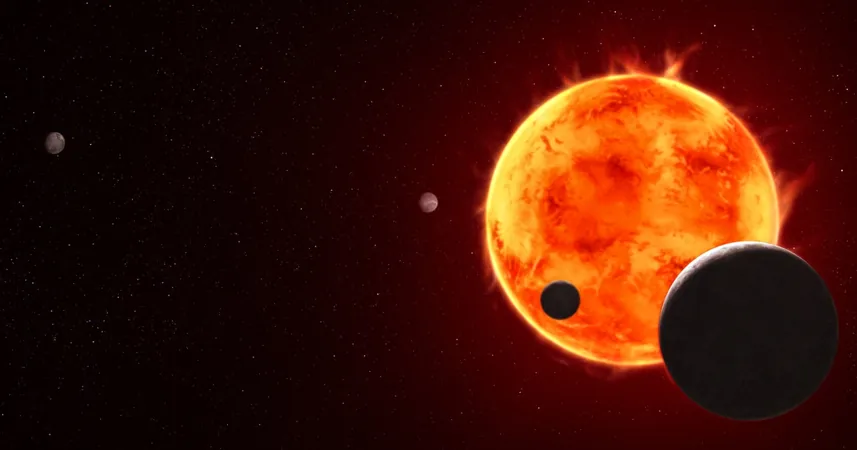
Could This Earth-Size Planet 40 Light-Years Away Hold Life?
2025-09-10
Author: Ming
A Potential Haven for Life?
Astronomers have spotted a rocky, Earth-sized planet nestled in our Milky Way galaxy that might just have the right atmosphere to support life. New research suggests the presence of a nitrogen-rich atmosphere around TRAPPIST-1e, one of the seven planets in the TRAPPIST-1 system. This raises tantalizing possibilities for liquid water on its surface, a critical factor for life as we know it.
Groundbreaking Research Unveiled
Two studies recently published in the Astrophysical Journal Letters, based on observations from NASA's James Webb Space Telescope, highlight the potential for TRAPPIST-1e to have an atmosphere akin to ours. However, further investigations are necessary to confirm these findings.
Mars and the Quest for Life
In related news, NASA also announced the possibility of ancient microbial life in Mars rock samples. Although present-day Mars has a thin atmosphere mostly of carbon dioxide, it might have supported liquid water billions of years ago. This underscores the significance of water as a key ingredient for life.
Why Atmosphere Matters
To retain water in liquid form, a planet needs an atmosphere; otherwise, the water could evaporate. The search for atmospheres around exoplanets is one of the most exciting endeavors in astronomy. "We aim to find planets where we can identify molecules indicative of life," explained Ryan MacDonald, an exoplanet astronomer from the University of St Andrews.
Discovering the TRAPPIST-1 System
Located 40 light-years from Earth, the TRAPPIST-1 system has been in the spotlight since its discovery in 2016. TRAPPIST-1e orbits in the "habitable zone," a sweet spot where temperatures may allow for the existence of liquid water.
Deciphering the Atmosphere
Using the James Webb Space Telescope, astronomers observed TRAPPIST-1e during its transits in front of its star. Although they couldn't directly see the atmosphere, they could measure the light spectrum to identify what gases may be present. Colors blocked or absorbed can reveal the presence of specific molecules.
Hints of Potential Life
While researchers found no evidence of a hydrogen-rich atmosphere or dominant carbon dioxide levels, they detected hints of a nitrogen-rich atmosphere. "This is an exciting step toward finding an Earth-like atmosphere," said Caroline Piaulet-Ghorayeb from the University of Chicago.
Titan and Beyond
For context, Earth's atmosphere is composed mostly of nitrogen, similar to Titan, one of Saturn's moons. Titan is thought to have an underground ocean, but its methane-rich environment suggests any life there would be quite different from Earth's.
Ongoing Investigations
The journey to confirm an atmosphere on TRAPPIST-1e is far from over. Researchers plan to investigate the planet during 15 more transits in the coming years. They will also explore three other planets in the system: TRAPPIST-1f, TRAPPIST-1g, and TRAPPIST-1h.
The Future of Exoplanet Research
The ongoing research is crucial for deepening our understanding of exoplanets and the potential for life beyond our solar system. "We still haven't convincingly identified an atmosphere on any rocky exoplanet, making this pursuit incredibly exciting," Piaulet-Ghorayeb added. The search continues!



 Brasil (PT)
Brasil (PT)
 Canada (EN)
Canada (EN)
 Chile (ES)
Chile (ES)
 Česko (CS)
Česko (CS)
 대한민국 (KO)
대한민국 (KO)
 España (ES)
España (ES)
 France (FR)
France (FR)
 Hong Kong (EN)
Hong Kong (EN)
 Italia (IT)
Italia (IT)
 日本 (JA)
日本 (JA)
 Magyarország (HU)
Magyarország (HU)
 Norge (NO)
Norge (NO)
 Polska (PL)
Polska (PL)
 Schweiz (DE)
Schweiz (DE)
 Singapore (EN)
Singapore (EN)
 Sverige (SV)
Sverige (SV)
 Suomi (FI)
Suomi (FI)
 Türkiye (TR)
Türkiye (TR)
 الإمارات العربية المتحدة (AR)
الإمارات العربية المتحدة (AR)